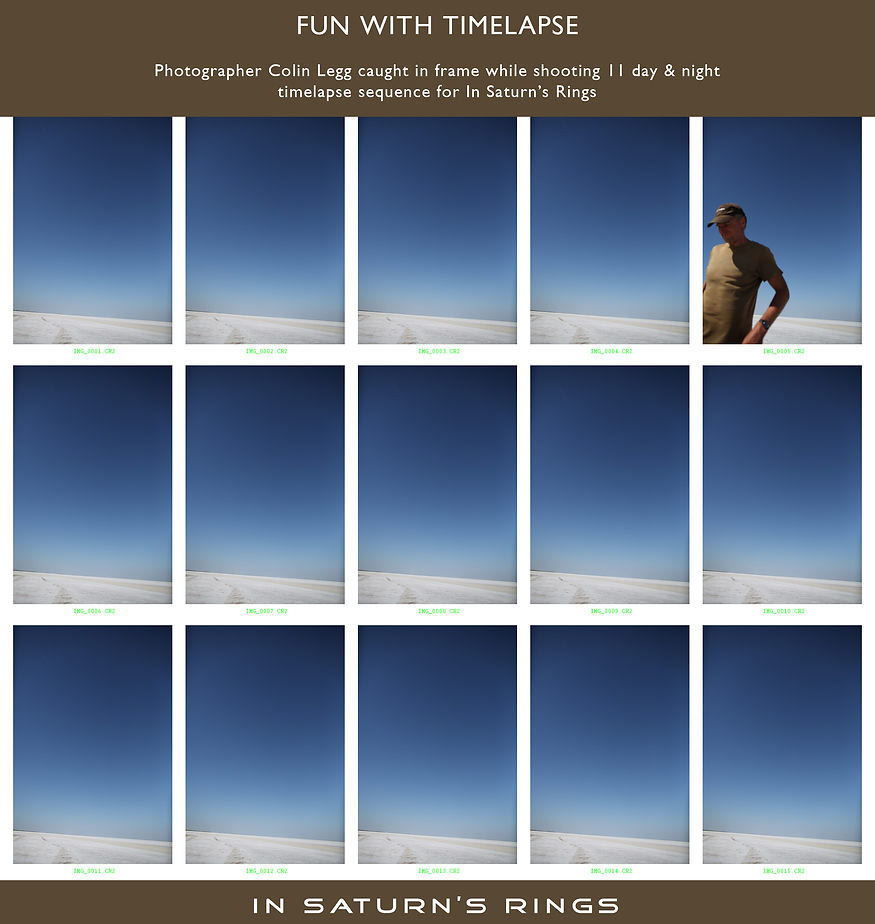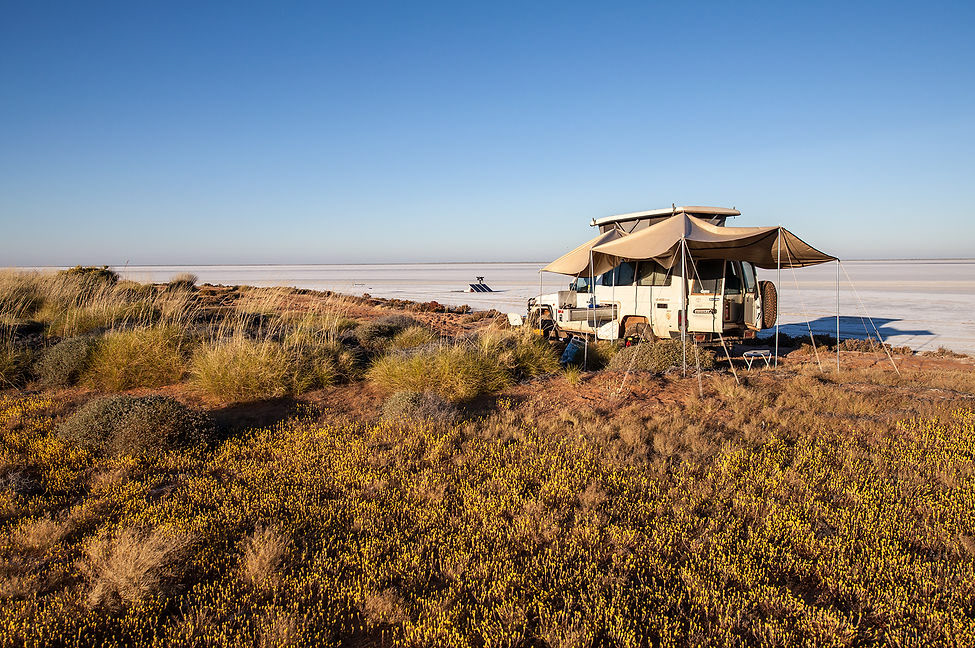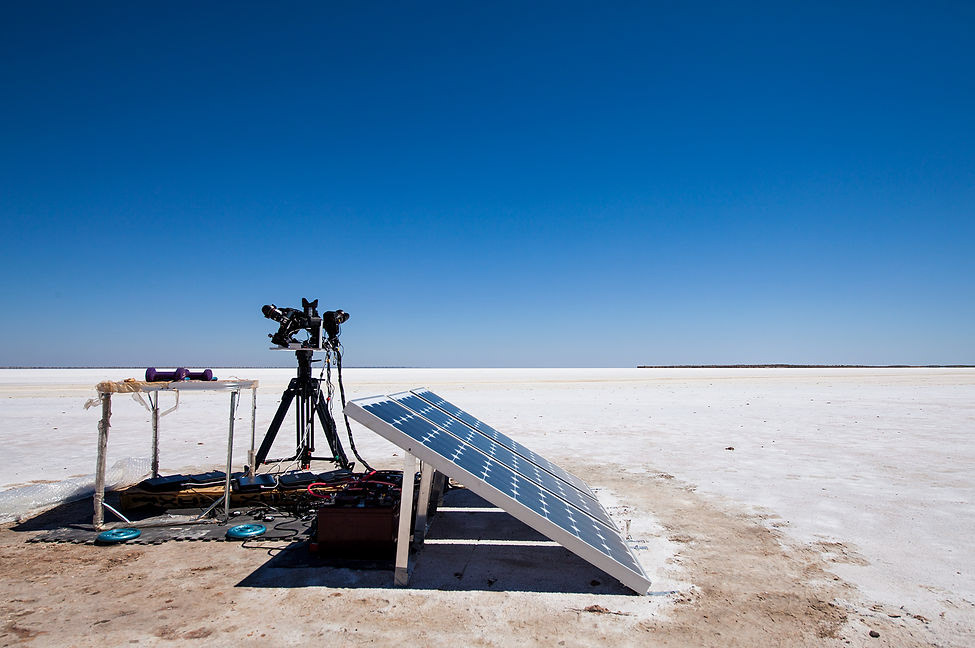5 CAMERA MILKY WAY TIME-LAPSE
Colin Legg: Photographer, Technician, Benefactor
Colin Legg embarked on a truly ambitious mission to capture stunning dark sky time-lapse footage in the wilds of Western Australia. He utilized a custom-built 5 camera rig using high-end DSLR’s and specialized electronics that captured some of the best dark sky time-lapse footage ever made.
Colin shot 11 days of day & night time-lapse footage for In Saturn's Rings and graciously donated this work to the film. It’s an amazing gift as the footage originally planned for use were stills stitched together. This incredible and one-of-a-kind footage blows that out of the water.
The shoot took place in a dry lake bed, Lake Dora, basically in the middle of nowhere. It’s about 90 km from nearest mining operation so there would be minimal light pollution.
11 DAYS & NIGHTS OF FILMING
Footage from Colin Legg
Colin Legg spent nearly 2 weeks (late August/early September 2011) capturing stunning dark sky time-lapse footage in the wilds of Western Australia. He trekked into the outback with a 5 camera rig using high-end DSLR’s and specialized electronics that captured some of the best dark sky time-lapse footage ever recorded.
The fantastic part is that he shot 11 days of continuous time-lapse footage for In Saturn's Rings and donated this work to the film. It’s an amazing gift as the original plan called for photo stills to be stitched together – nice stills but these pale in comparison to the footage received from Colin's epic adventure.
Approximately 111,000 photographs were shot in Canon raw format, 5 photographs per frame with each camera firing simultaneously. Each set of 5 images were stitched using a program called PTGui into a single 10K image. In the end there were approximately 20,000 images and we ended up using 10,000 images for the film.
THE SHOOT
The plan was to shoot an 11 day continuous time-lapse sequence, 5 days on either side of the new moon. Changing light was tracked as smoothly as possible in camera and all 5 cameras fired together. Images from each camera were stitched together to cover 160 degrees of sky. The sequence will be used for the key film sequence that shows the loss of the night sky over the entire history of human civilization.
The plan was to shoot an 11 day continuous time-lapse sequence, 5 days on either side of the new moon. Changing light was tracked as smoothly as possible in camera and all 5 cameras fired together. Images from each camera were stitched together to cover 160 degrees of sky. The sequence will be used for the key film sequence that shows the loss of the night sky over the entire history of human civilization.
THE EXPEDITION
The shoot took place in a dry lake bed, Lake Dora in Australia, basically in the middle of nowhere. It’s about 90 km from nearest mining operation so there would be minimal light pollution.
It’s far enough north to escape most southerly winter storm systems but far enough south to avoid tropical lows, with a very high chance of clear skies. Of course, nothing is easy shooting in the wilds but as you will see everything went very well.
THE TIME-LAPSE RIG
The rig was built using five Canon 5D Mark II DSLR cameras arranged to capture a 160 degree panoramic time lapse with sophisticated electronics and software to control the cameras during the shoot. The rig allows all camera to fire at once and manage the exposure as light changes from day to night to day. By using five 5 Canon 5D’s, it gave better resolution and lower noise than even 15/70mm film used in IMAX and other giant screen productions.
"Colin had a lot of help from many key people and I'm indebted to all of them." - Stephen van Vuuren
1. Uta Bauer provided logistics and support.
2. David Gargadennec designed and built the 5 camera mount, power systems and contributed post processing advice.
3. Thomas Bethell built an 8 camera bulb firing and monitoring micro-controller for the project. He is a pioneer in bulb ramping camera controllers for smoothly tracking light (sunrise/sunset/moonrise/moonset).
4. Fred Bruenjes is the developer of Eclipse Orchestrator software used in adjusting camera settings and orchestrating and timing the 11 day sequence. He modified his software to Colin’s needs for the shoot.
5Carsten Oehring – Created custom power systems engineering to keep all 5 cameras and supporting gear running.
2. David Gargadennec designed and built the 5 camera mount, power systems and contributed post processing advice.
3. Thomas Bethell built an 8 camera bulb firing and monitoring micro-controller for the project. He is a pioneer in bulb ramping camera controllers for smoothly tracking light (sunrise/sunset/moonrise/moonset).
4. Fred Bruenjes is the developer of Eclipse Orchestrator software used in adjusting camera settings and orchestrating and timing the 11 day sequence. He modified his software to Colin’s needs for the shoot.
5Carsten Oehring – Created custom power systems engineering to keep all 5 cameras and supporting gear running.


